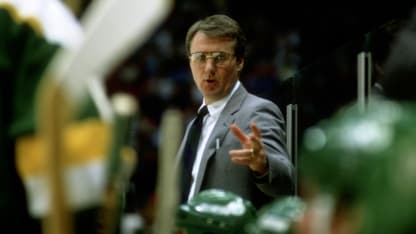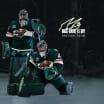The State of Hockey has become the State of College Hockey this season, as all five Division I men's schools have spent a majority of the season among the nation's ranked teams.
It was a vision laid forth by Herb Brooks three decades ago that has finally come true.
Brooks, a former coach at the University of Minnesota, in the NHL, and perhaps most notably, the coach of the 1980 U.S. "Miracle on Ice" Olympic team, believed that Minnesota could be the country's best state for college hockey.
Brooks' Legacy Alive in State of College Hockey
All five Division I teams in Minnesota have been in the national rankings for large parts of this season

In the mid-1980s, it was a bold statement.
Both Michigan and Massachusetts had several more D-I programs, many of which had experienced success at the national level.
So, along with another former Gopher coach John Mariucci, the two put into motion a plan to grow college hockey in Minnesota so that it could rival other states around the country. It began with a bold -- and surprising -- choice to take the head coaching position at a Division III school.
'Legendary status'
A former Husky player and a first-year assistant coach at SCSU at the time, Bob Motzko remembered what it was like when Brooks called the team's first meeting.
Six years removed from winning the Gold Medal in Lake Placid, Brooks commanded the room like a general. Motzko, today in his 12th season as the Huskies head coach, said plans to move the program from Division III were moving slowly.
"I remember there was talk of a five-year plan to go Division I," Motzko said. "Well, Herb came in, I think he did it in one year. Within one year, we were independent, plans to build a new arena and making progress to get into the WCHA. That was the power and the impact of Herb Brooks.
"He was legendary status."
As a D-III school, SCSU held open tryouts each season. Before Brooks' arrival, Motzko said, about 35 guys would show up. With the Olympic hero behind the bench, about 70 or 80 players wanted to wear Husky uniforms for the one season Brooks was there.
"You could hear a pin drop, just the magnitude of him walking in," Motzko said.
While his stay in St. Cloud was short -- he was back behind an NHL bench in 1987-88 -- Brooks' involvement in the SCSU program had wide-ranging effects that are still felt today.
"I hear stories now that I've been back 12 years, the business leaders will tell me the story, 'Well, the first time I met Herb, he wanted me to buy season tickets,'" Motzko said. "He was boots on the ground, even in the community, trying to get people to rally around it. It was a major impact, not just on our school and that group of players for one year, but in the community. There were people that started coming to hockey games for the first time that are still season ticket holders from that first year."
Building it out
At the same time SCSU jumped to Division I, the Golden Gophers and University of Minnesota-Duluth Bulldogs were the only D-I teams in the state, but others were experiencing success.
Minnesota State had won a Division II championship in 1980 and had been to several Frozen Fours at that level.
Bemidji State had won a handful of championships at the NCHA, Division II and Division III levels in the 80s and 90s.
Encouraged by St. Cloud State's move to Division I, Minnesota State moved up in 1996. Three years later, Bemidji State made the jump.
At long last, the vision of Brooks and Mariucci -- one where college hockey in Minnesota was thriving at the Division I level -- was beginning to come into focus.
MSU made its first NCAA Tournament in 2003. BSU went to the Frozen Four in 2009. UMD won its first NCAA National Championship at Xcel Energy Center in 2011.
But in 2013, college hockey realignment shifted the balance of power away from a few and laid the groundwork for today's success.
Ups and downs
During the 2000s and early 2010s, one thing was certain almost every season: Minnesota would be the best in-state team in the WCHA and everyone else would occasionally challenge.
The Gophers won back-to-back national championships in 2002 and 2003, and for the rest of the decade, they were consistently in the conference championship mix.
Minnesota State jumped up for a year in 2003, then fell back. Duluth would put together an occasional great year, then see its luck wane. Likewise, St. Cloud State would have a decent season, then take a step back.
Bemidji State, in the far-flung College Hockey America conference, had plenty of success. But facing inferior competition, it was routinely bounced once it played teams in better leagues.
For years, the Beavers wished to join their in-state brothers in the WCHA. Finally, after building a state-of-the-art arena on the shores of Lake Bemidji, BSU was admitted to the league in 2010.
But the reunion was short-lived.
Three years later, Penn State University began play as a Division I school, forcing Minnesota and the University of Wisconsin to join the Big Ten Conference.
With those schools gone, others created the National Collegiate Hockey Conference, taking UMD and SCSU with them. That left BSU and MSU as the only remaining teams from Minnesota in the WCHA and separated the five in-state schools into three separate conferences.
There have been pitfalls, for sure. But it has allowed all five teams to routinely compete for conference championships in their new leagues.
Minnesota State, having never won a conference title in Division I, has won two regular season championships and two more playoff titles. Bemidji State is the heavy favorite to win its first WCHA regular season title this season.
Since winning their national championship in 2011, the Bulldogs have become a consistent contender on the national stage and have been atop the USCHO.com rankings for a good portion of this season.
SCSU has hung multiple NCHC championship banners over its first three years in that new league.
And, perhaps unsurprisingly, Minnesota has consistently been the Big Ten's best team.
Earlier this fall, all five teams in the state were ranked in the top 20 of the USCHO national rankings for the first time.
"By splitting off, maybe that has helped programs," said Gophers coach Don Lucia, whose team plays at Wisconsin Saturday as part of Hockey Day Minnesota 2017. "All of the sudden, Bemidji and Mankato are top dogs in the WCHA. Duluth and St. Cloud have continued to prosper in the NCHC.
"If we went back, I don't know if everybody is going to be having the same success."
Ties that bind
Like the vision Brooks and Mariucci had in helping expand the footprint of college hockey in Minnesota, the state's current Division I head coaches all have unique bonds and ties to each other.
Motzko and Minnesota State coach Mike Hastings went to school together at SCSU. Both Hastings and Motzko have served as assistant coaches at Minnesota under Lucia.
Motzko counts Bemidji State coach Tom Serratore as one of his best friends. Serratore and UMD coach Scott Sandelin have a friendship that has dated back to their childhood, when Serratore would spend summer weekends in Sandelin's hometown of Hibbing.
Just recently, Sandelin's son, Ryan, committed to play collegiately for Hastings in Mankato. Hastings has also coached Lucia's son, Tony, in Omaha of the United States Hockey League.
"The small world of hockey in the state of Minnesota," Hastings said. "I've got a lot of respect for those guys, one, because I've worked with a majority of them, but two, because I consider them friends."
Keeping the legacy alive
As coach of the Gophers, Lucia has often followed in the footsteps of Brooks when it comes to maintaining the legacy of college hockey in the state.
When conference realignment threatened to make life difficult in Mankato and Bemidji, Lucia was instrumental in the creation of the North Star College Cup, so that fans in those markets could still get the Gophers to come to town, a draw that often fills the building and sells hotel rooms in town.
Lucia has also done his part to schedule in-state teams in nonconference games, so their programs can get time on television and maintain natural rivalries. Along with former Gopher Athletic Director Joel Maturi, the university also had a lot to do with Bemidji State's admittance to the WCHA.
After the CHA had folded, Bemidji's program was on life support not long after its trip to the Frozen Four. But in the spirit of Brooks and Mariucci, Lucia knew what he had to do, even if it wasn't going to be easy.
"There was some politicking that had to go on," Lucia said. "I grew up [in Grand Rapids] and Bemidji had a great Division II program and when I was at Fairbanks, we played them in the Division II semifinals. You never want to see a program go away.
"Some people don't understand the dynamic that makes our sport great. You can have a Division II institution, you can have a Division III institution and they can play on par with a BCS school. You can't do that in any other sport."
With all five teams now at or near the top of their conferences, Motzko said Brooks would be thrilled with the progress college hockey has made in Minnesota.
It's been a slow and steady build, but fans of all five schools could be entering the golden age of college hockey in the state.
At the very least, the legacy and mission of Brooks is alive and well.
"It gives kids more opportunities to play," Sandelin said. "There are plenty of talented kids around the state of Minnesota. We have a lot of them on our teams, but they are going other places, too. But it's certainly giving them the opportunity to play in their home state. That creates a lot of excitement."


















